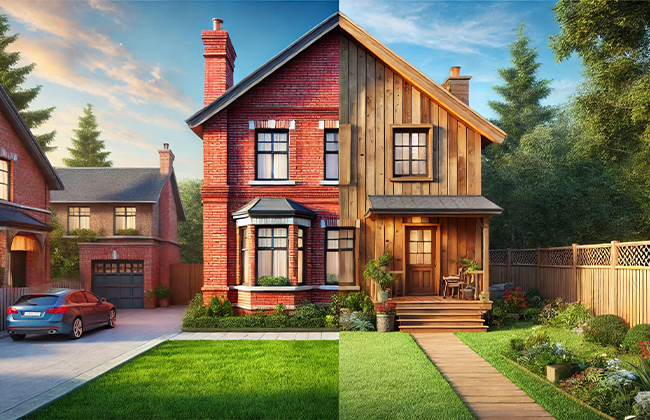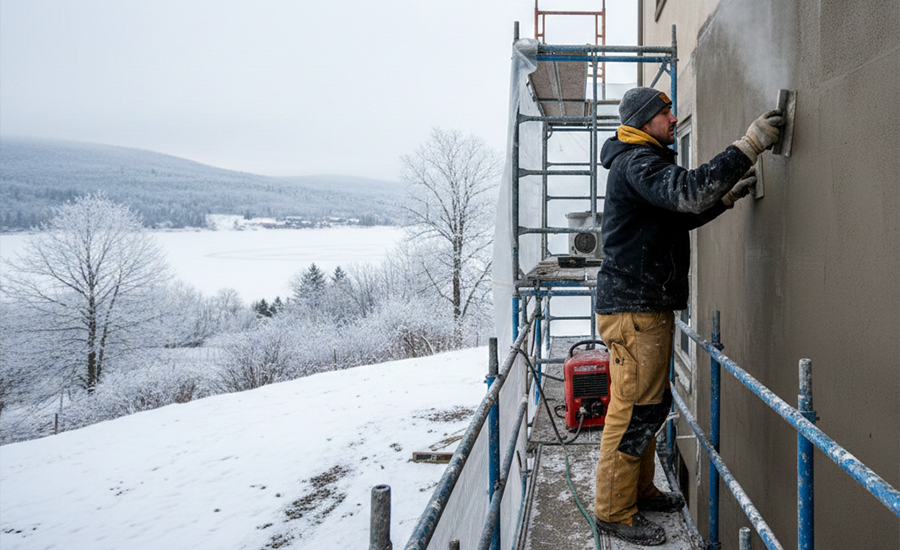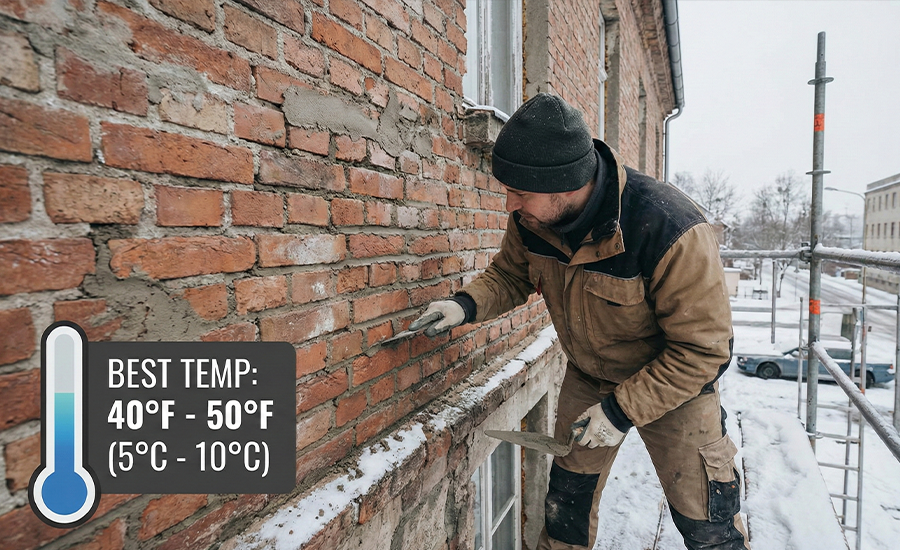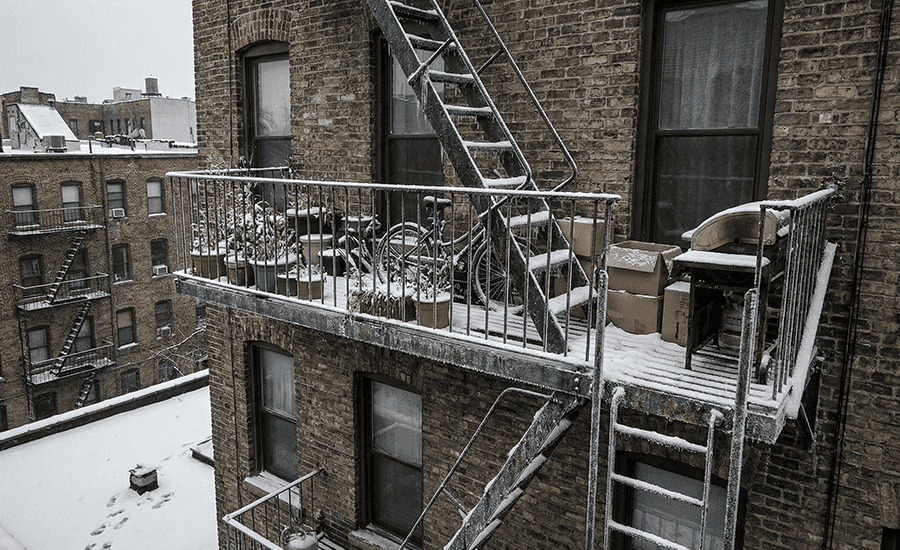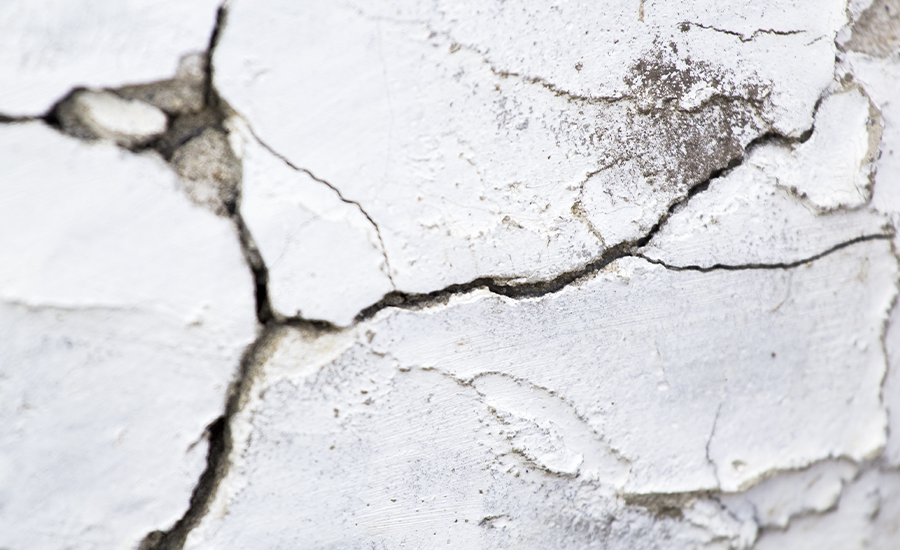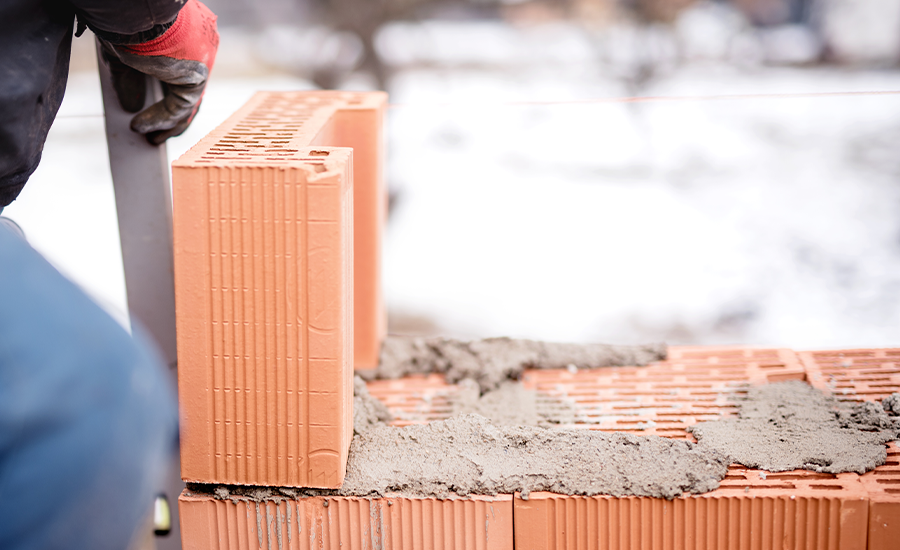Are you debating the merits of a brick vs wood house?
Each option brings distinct advantages, from the sturdy and low-maintenance nature of brick to the natural charm and warmth of wood. This detailed comparison will cover aspects such as cost, durability, maintenance, energy efficiency, and aesthetic appeal. Understanding these differences can guide your decision whether you’re planning a new build or contemplating a renovation.
Overview of Brick and Wood Houses
If you’re at the crossroads of deciding between a brick house and a wood house, you’re not alone. It’s a choice that homeowners have grappled with for generations. Each material brings its own flavor to the table, setting the stage for a home that’s not only a place to live but a statement of style and sustainability. Let’s break it down and see what each material has to offer, so you can make a choice that feels right for you.
Definition and Historical Usage
Brick and wood have carved their paths through history as primary building materials. Bricks, made from fired clay, boast a legacy that stretches back to ancient civilizations. They are renowned for their robustness and have been a part of the architectural fabric of societies worldwide. Wood, conversely, has been the backbone of construction in forest-rich regions, embodying flexibility and a quick-to-adapt character that makes it ideal for diverse architectural styles.
General Properties of Each Material
Bricks are the marathon runners of building materials—tough, weather-resistant, and low-maintenance, they offer a reliable choice for any construction. They’re excellent at fire resistance, which can be a game-changer when it comes to safety. Wood, with its inherent insulation properties, offers an eco-friendly option that can keep your energy bills down. It’s also incredibly versatile, allowing for intricate designs and a warm, inviting look. However, it requires more maintenance to protect against elements like rot and insects.
Now, let’s take a closer look at how these materials stack up, especially when it comes to your budget. Both brick and wood bring unique benefits and challenges, which are critical to understand as you plan the foundation of your future home. From the rustic charm of wood to the sturdy reassurance of brick, your choice will shape not just your home’s look but also its feel and functionality. Next, we’ll dive into the costs associated with each material to see which might be the most cost-effective option for your new home.
Cost Analysis of a Brick vs Wood House
When it comes to building your dream home, the financial side of things can really make you think twice. Let’s get into the nitty-gritty of what it actually costs to build with brick versus wood. We’ll look at both the initial price tag and the ongoing costs, so you can see where your money is going and why.
Initial Costs: Materials and Construction
Building a house isn’t just about stacking bricks or hammering nails; it involves a whole series of costs right from the get-go. Here’s a quick breakdown of the initial costs associated with brick and wood homes:
| Material | Cost per Square Foot | Construction Labor | Total Initial Cost |
| Brick | $15 – $30 | High due to skilled labor | $30,000 – $60,000 for a 1,000 sq ft home |
| Wood | $10 – $20 | Lower due to easier handling | $20,000 – $40,000 for a 1,000 sq ft home |
Bricks can be pricey, but they compensate with durability and less maintenance. The labor for brickwork, requiring skilled masons, also adds to the initial cost.
Wood is generally more budget-friendly upfront and quicker to build with, which can save on labor costs. However, the choice of wood and its treatment can affect the final expense.
Long-term Costs: Maintenance, Repairs, and Energy Efficiency
After the dust settles and the last nail is driven, the long-term costs start to take shape. Let’s look at how brick and wood stack up over the years:
| Material | Maintenance Costs | Average Annual Repairs | Energy Efficiency |
| Brick | Low | Minimal | High due to thermal mass |
| Wood | High | Regular upkeep needed | Moderate, varies with insulation quality |
Brick Houses excel in reducing long-term expenses thanks to their formidable resistance to elements and pests, which means less money spent on repairs. Their thermal properties also help in keeping those energy bills lower.
Wood Houses might need more TLC over the years, with costs creeping up for treatments and repairs due to susceptibility to rot and pests. While wood is a good insulator, achieving optimal energy efficiency might require additional insulation work.
Grasping these costs upfront can help you plan better for both the immediate and the distant future, ensuring your home not only looks great but is also a wise financial decision. Up next, we’ll delve into how these materials hold up over time in our discussion on durability and maintenance.

Transform your home with expert masonry services. Contact us today for a free consultation.

Durability and Maintenance
When it comes to choosing the material for your house, it’s not just about the immediate aesthetics or costs—it’s also about how long your home will stand up to the test of time and the elements. Let’s dive into the durability and maintenance of brick versus wood homes to see which might keep you cozy and worry-free for longer.
Lifespan of Brick vs. Wood Structures
First things first: How long are these materials going to last?
Brick houses are like the strong, silent type—they’re built to last. On average, a well-built brick home can last over 100 years with minimal fuss. The endurance of brick is renowned; it doesn’t rot, it’s resistant to fire, and pests like termites are just not a problem.
Wood, while naturally beautiful and flexible, tends to have a shorter lifespan if not properly maintained. A wood structure can stand strong for decades—commonly 20-30 years, but it can last much longer with the right care and maintenance. However, wood is susceptible to rot, pest infestation, and fire, which can significantly reduce its lifespan if not addressed.
Required Upkeep and Vulnerability to Elements
Now, let’s talk about the upkeep. Maintaining a home is no small feat, and the material you choose can really change the amount of work you’ll need to put in.
Brick: Here’s the good news—if you’re not a fan of constant upkeep, brick might be your best friend. Bricks require far less maintenance because they’re so resilient against weather and wear. You might need to repoint the mortar every 25-30 years, but aside from that, bricks are pretty much set it and forget it.
Wood: If you’re going with wood, prepare for a bit more hands-on maintenance. Wood needs to be treated for water resistance, pests, and might need a fresh coat of paint or sealant every few years to keep it looking fresh and to protect it from the weather. This regular maintenance is crucial to prevent deterioration and to extend the life of a wood house.
So, while both materials have their own charm and challenges, when it comes to durability and maintenance, brick generally takes less effort to keep up over the years. Choosing between these materials isn’t just about the look—it’s about how much time and effort you’re willing to invest in upkeep.
As we wrap up this discussion on the robustness and care needed for different building materials, it’s clear that both brick and wood have their merits and maintenance demands. Now, as we consider these practical aspects, it’s equally important to think about how these materials can shape the look and feel of your home. Next, we’ll explore the aesthetic and design flexibility of both brick and wood, diving into how each material can align with your personal style and architectural vision.
Aesthetic and Design Flexibility
Picking between brick and wood isn’t just a practical decision—it’s a style statement! How do these materials translate your personal taste into your home’s design?
Let’s delve into the distinctive styles and customization options that each offers.
Architectural Styles and the Aesthetic Appeal of Each Material
Brick: Imagine a material that can easily switch from historical elegance to modern chic. That’s brick for you! It’s versatile, offering:
- Color Variety: From deep burgundies to earthy tans, the color of brick can shape the personality of your home.
- Texture Options: Smooth, rough, or anywhere in between, each texture adds a different dimension to your home’s facade.
- Patterns: Ever seen a zigzag or circular pattern in brickwork? Such patterns can turn a simple wall into a statement piece.
Brick adapts effortlessly across various architectural styles, enhancing the character of any home, whether it’s a cozy bungalow or a sleek contemporary loft.
Wood: Wood has a natural charm that can make any home feel like a retreat. It’s perfect for:
- Natural Aesthetics: With its rich textures and varied grains, wood brings a touch of nature to any setting.
- Flexibility in Finishes: Stain it, paint it, leave it natural—the choice is yours and can dramatically alter the look of your home.
- Craftsmanship: Wood allows for detailed craftsmanship, perfect for custom trim and decorative accents.
Wood is a go-to for those looking to create a warm, inviting home, from rustic log cabins to modern minimalist designs.
Customization Options and Regional Preferences
Brick is more than just sturdy; it’s stylish. In regions with severe weather, its durability is a big plus, but its ability to maintain its look over years makes it a perennial favorite. Whether you’re in the humid Southeast or the cold Northeast, brick stands up to the elements while keeping its cool.
Wood offers unmatched versatility in customization:
- Architectural Details: Carve, shape, and style it to your heart’s content.
- Regional Suitability: In wooded areas or places with a rich tradition of wooden structures, it blends right in, making it a popular choice in both the rustic countryside and chic urban neighborhoods.
Both brick and wood let you play architect, tailoring your home not just to your needs but also to your whims. As we’ve explored how these materials transform aesthetics, let’s not overlook how they perform behind the scenes. Coming up, we’ll dive into the energy efficiency and insulation properties of each, ensuring your home is as comfortable as it is beautiful.

Transform your home with expert masonry services. Contact us today for a free consultation.

Energy Efficiency and Insulation
When you’re building a house, thinking about energy efficiency isn’t just smart—it’s essential. How well your home keeps the heat in during winter and out during summer can make a huge difference in your comfort and your utility bills. Let’s dig into how brick and wood stack up in terms of insulation properties and their impact on heating and cooling costs.
Comparative Insulation Properties
Brick: Brick’s got a bit of a dual personality when it comes to insulation. It’s not naturally the best insulator, but it has excellent thermal mass. This means it absorbs and holds heat, which can be a boon in cooler climates as it slowly releases heat back into the home during colder nights. However, this same quality can be a drawback in hot climates where you don’t want heat held inside your home. Here’s where strategic use of insulation materials in conjunction with brick can optimize its performance.
Wood: Wood is naturally an excellent insulator, thanks to the air pockets within its cellular structure. This natural advantage helps keep homes warmer in the winter and cooler in the summer more efficiently than brick. Wood’s insulation value makes it a favorite for regions with significant temperature swings, as it helps maintain a comfortable indoor environment without over-relying on heating and cooling systems.
Impact on Heating and Cooling Costs
Now, let’s talk about what this all means for your wallet:
Brick Homes: While the upfront installation of brick might not offer high insulation, the thermal mass can help reduce heating costs in cooler climates by retaining heat. In warmer climates, proper insulation techniques need to be employed to prevent excessive heat retention, which can increase cooling costs.
Wood Homes: Thanks to its superior insulative properties, wood can be more cost-effective in maintaining comfortable temperatures year-round. Lower reliance on heating and cooling systems can lead to significant savings on energy bills, especially in areas with extreme weather conditions.
Choosing the right material based on your local climate and the specific energy efficiency needs of your household can lead to long-term savings and a smaller environmental footprint.
Both brick and wood have their pros and cons in terms of energy efficiency, and each can be a smart choice depending on your needs and where you live. As we wrap up this look into the thermal dynamics of building materials, let’s shift our focus to how these choices might affect the resale value and market preferences for your home. After all, it’s not just about being cozy and saving on bills—it’s also about making a sound investment.
Resale Value and Market Preferences
Thinking about selling your home in the future?
Your choice of building material doesn’t just shape your current lifestyle—it also plays a huge role in your home’s potential resale value. Let’s dig into how the choice between brick and wood could affect your wallet down the road, and what’s trending in the housing market.
How Material Choice Affects Property Value
Brick: Here’s the scoop—brick homes often catch a buyer’s eye for a few good reasons:
- Sturdy Appeal: Brick’s solid appearance can suggest durability and quality, key selling points.
- Aging Gracefully: Unlike other materials, brick can age beautifully, gaining character over time, which can be a huge plus on the market.
- Low Upkeep: Potential buyers are often drawn to homes that won’t need constant care, and brick’s minimal maintenance fits this bill perfectly.
All these factors mean that when it’s time to sell, a brick home can command a premium price.
Wood: Wood’s got its own set of perks that can sweeten the deal for future buyers:
- Warmth and Character: A wood home stands out with its natural charm and warmth, which can be a major draw.
- Customizable: Buyers interested in a home they can personalize may be attracted to wood for its ease of modifications and updates.
- Sustainability: In today’s market, eco-friendly homes are increasingly popular. Wood, especially if sustainably sourced, can be a big selling point.
Wood homes might require more upkeep, but with the right care, they can remain highly desirable in the resale market.
Current Trends in Housing Material Preferences
What are homebuyers looking for these days?
Here’s the lowdown:
Brick Trends: In regions where longevity and classic design are in vogue, brick homes remain a top choice. They’re often preferred in areas with extreme weather, thanks to their natural resilience.
Wood Trends:
- Eco-Friendly Choices: With a growing emphasis on sustainability, wood is increasingly favored for its renewable qualities.
- Modern Rustic Vibes: There’s a rising trend for homes that blend rustic aesthetics with modern comforts, and wood is perfect for this look.
Understanding these trends and how they relate to your home’s material can help you enjoy your current living space. It can also help you strategize for a future sale.
With all this in mind, as we reflect on the financial implications and personal preferences shaping our choices, it’s also crucial to consider the bigger picture. Coming up, we’ll explore how each material stacks up in terms of environmental impact, rounding out our discussion with a look at sustainability and ecological responsibility.
Environmental Impact
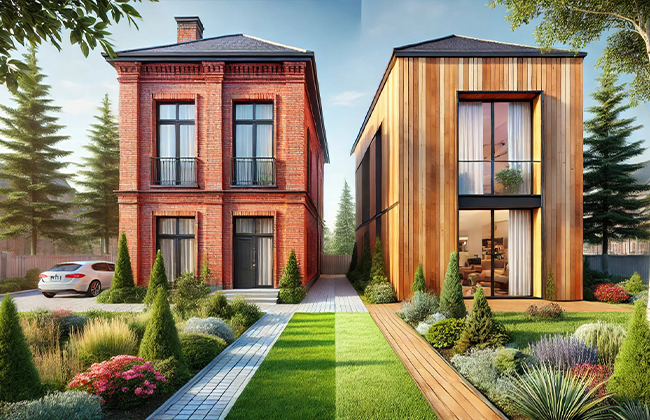
When choosing the material for your home, it’s not just about aesthetics or cost—it’s about making choices that positively impact the world around us. Let’s unpack the environmental considerations of building with brick and wood, focusing on sustainability and the ecological footprint from production to disposal.
Sustainability of Materials
Brick: Bricks have some strong points when it comes to sustainability:
- Longevity: They last incredibly long, which means less need for replacement and less waste.
- Recyclability: Old bricks can often be recycled for new construction or other uses, which helps reduce landfill waste.
- Natural Materials: Made from clay and shale, bricks are produced from abundant natural resources, although the firing process is energy-intensive.
However, the kiln firing required to make bricks is a significant source of CO2 emissions. Innovations in production technology are aiming to reduce these impacts, making brick a more eco-friendly option over time.
Wood: Wood shines as a sustainable building material, but with a few caveats:
- Renewable Resource: Wood comes from trees, a renewable resource—especially when sourced from well-managed forests.
- Carbon Sequestration: Wood captures and stores carbon dioxide, which can help combat climate change.
- Energy Efficiency: The production of wood materials requires less energy compared to many other building materials, resulting in lower carbon emissions.
The key to maximizing wood’s environmental benefits is ensuring it comes from sustainably managed forests. Also, consider the treatment and preservation chemicals used, which can affect its overall ecological footprint.
Environmental Footprint of Production and Disposal
Brick Production: The production of bricks is energy-intensive, primarily due to the high temperatures needed to fire them. This process consumes significant amounts of energy and can emit pollutants. However, because bricks are durable and low-maintenance, the long-term environmental impact can be mitigated somewhat.
Wood Disposal: Wood’s end-of-life phase can be more environmentally friendly than many other materials. It’s biodegradable and can be repurposed or recycled into new products, reducing its overall environmental impact. The disposal process, when managed properly, adds minimal pollutants to the environment compared to materials that require significant processing.
Choosing materials with a favorable environmental profile helps reduce your ecological footprint. It also aligns with a growing demand for sustainable living practices.
As we consider how building materials affect the environment, it’s also crucial to consider their impact on our health and safety. Next, we’ll dive into how both brick and wood measure up in terms of safety and health considerations, ensuring your home is a safe haven for years to come.

Transform your home with expert masonry services. Contact us today for a free consultation.

Safety and Health Considerations
When it comes to building your home, the safety and health of your family are paramount. Beyond just looking good or being durable, the materials you choose should also protect and promote a healthy living environment. Let’s delve into how brick and wood stack up in terms of fire resistance, safety features, and health impacts from off-gassing.
Fire Resistance and Safety Features
Brick: Brick is a champion when it comes to fire resistance. Here’s why:
- Non-combustible: Brick doesn’t burn, which makes it an excellent barrier against fire.
- Heat Resistance: It can withstand extremely high temperatures, helping to prevent the spread of fire from outside sources.
The solid nature of brick also adds a layer of security against external impacts, whether from nature or accidental bumps. This makes brick homes a safe bet for areas prone to wildfires or where safety concerns are a priority.
Wood: Wood, while beautiful, faces some challenges here:
- Combustible: Unlike brick, wood is inherently flammable, which can be a concern in areas with high fire risk.
- Treatment: Many wood homes are treated with fire retardants to improve safety, but these can have varying levels of effectiveness.
However, modern building codes and treatments have significantly improved the fire safety of wood structures. This makes them safer than in the past. They are still not on par with brick in terms of inherent fire resistance.
Health Impacts Related to Material Off-Gassing
Brick: One of the healthiest aspects of brick is that it off-gasses minimally, if at all. Since it’s made from natural materials that are fired at high temperatures, any volatile organic compounds (VOCs) are typically burned off during production. This means cleaner indoor air quality and fewer health concerns related to air pollution indoors.
Wood: Here’s where wood requires a bit more consideration:
- Natural VOCs: Wood naturally emits some VOCs, like terpenes, which can affect air quality. However, these are generally less concerning than synthetic VOCs.
- Treatments and Finishes: The real issue often lies with the treatments and finishes applied to wood. Some of these can off-gas chemicals like formaldehyde, especially if the wood is part of composite products like pressed wood or particleboard.
Choosing low-VOC finishes and sustainably sourced wood can help mitigate these health impacts, making wood a safer and more health-friendly option.
Choosing the right building materials involves balancing aesthetics, cost, durability, and environmental impact. This should never be at the expense of safety and health. By understanding the safety features and health implications of brick and wood, you can make informed decisions. This ensures your home is not only beautiful and functional but also a safe, healthy environment for everyone inside. As we wrap up our comprehensive look at these popular building materials, remember that the best choice depends on your specific needs and circumstances. Aligning safety with style and sustainability is key.
Conclusion
Deciding between a brick vs wood house involves several factors. Brick houses are known for their durability and lower maintenance needs, making them a long-term investment. Wood houses bring distinct aesthetic advantages and might be more budget-friendly initially. If you’re looking to build or repair a brick house and need professional guidance, don’t hesitate to reach out. For specialized brick house repair, contact us at (+1) 917-355-8556 for expert assistance.
FAQs
Q: What are the primary advantages of a brick vs wood house?
A: A brick vs wood house comparison shows that brick offers superior durability and lower maintenance. Meanwhile, wood provides better insulation and aesthetic flexibility.
Q: How does energy efficiency compare in a brick vs wood house?
A: In a brick vs wood house scenario, wood typically offers better insulation. This can lead to more efficient heating and cooling compared to brick.
Q: Is a brick home better than wood?
A: Brick homes offer greater durability and lower maintenance. This makes them better for long-term stability compared to wood, which requires more upkeep.
Q: What are the disadvantages of brick houses?
A: Brick houses can be more expensive to build and less insulating by nature, requiring additional insulation to maintain energy efficiency.
Q: Why are American houses made of wood not bricks?
A: Wood is more abundant and less expensive in many parts of the U.S. This makes it a cost-effective choice for building compared to brick.
Q: Is brick the best material to build a house?
A: Brick is excellent for durability and fire resistance, but it may not be the best for all due to higher costs and poor insulation properties.
Q: Are brick houses safer in a tornado?
A: Brick houses can offer more protection against flying debris during a tornado than wood houses, due to their sturdy construction.
Q: What is the best house for a tornado?
A: A house designed with reinforced concrete or a specific tornado-resistant design is best for withstanding tornadoes effectively.
Q: Can a wood frame house withstand a tornado?
A: While wood frame houses are vulnerable to strong winds, proper design and building techniques can enhance their resistance. This can make them more resilient to tornadoes.
Q: What wind speed can a brick house withstand?
A: Brick houses can generally withstand higher wind speeds than wood, up to 130 mph, depending on construction quality and design.
Q: Is it cheaper to build a house with wood or brick?
A: Generally, it is cheaper to build with wood due to lower material and labor costs compared to brick.
Q: Is a brick house worth it?
A: Investing in a brick house can be worth it due to its longevity, low maintenance, and better resale value, despite the higher initial cost.
Q: What maintenance should I expect with a brick vs wood house?
A: Maintenance for a brick vs wood house varies; brick generally requires less upkeep. Wood may need regular treatments to resist elements.
Q: Can a wood house be as durable as a brick house?
A: While a wood house can be quite durable with proper care, a comparison often finds brick more resilient. Brick houses tend to withstand weather and time better.
Q: What should I consider when choosing between a brick vs wood house?
A: When evaluating a brick vs wood house, consider your local climate and maintenance preferences. Also, think about upfront costs and aesthetic desires to determine the best fit for your lifestyle.
Q: How do maintenance requirements compare in a brick vs wood house?
A: Maintenance for a brick vs wood house varies significantly. Brick houses generally require less frequent maintenance due to their resilience against weather and pests. Wood houses, however, may need regular treatments to protect against rot, insects, and weather-related damage.

Transform your home with expert masonry services. Contact us today for a free consultation.



